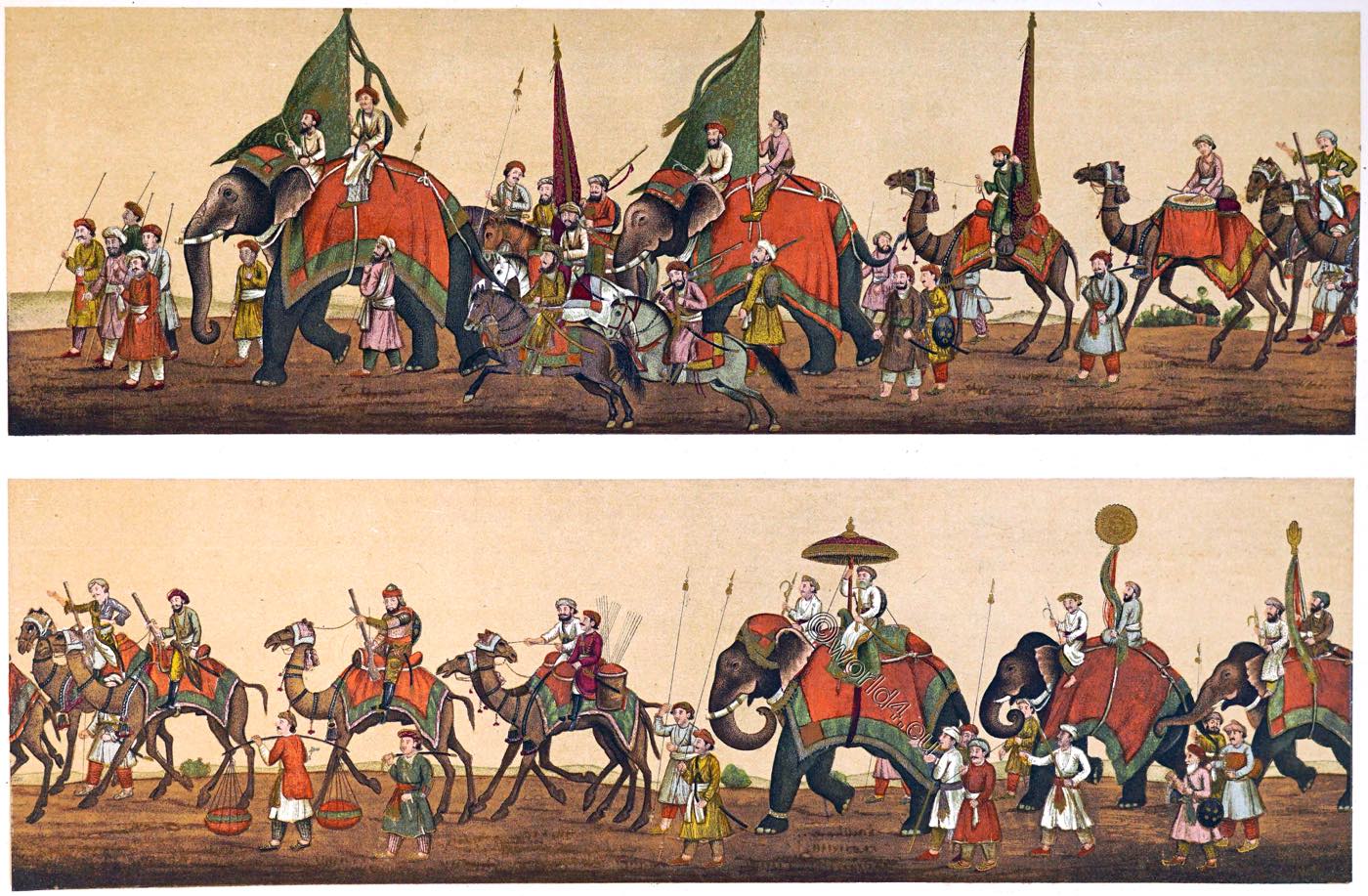Akbar Shah II (born 22 April 1760; died 28 September 1837 in Delhi, born as Mirza Akbar), also Akbar II, was 16th Emperor of the Indian Mughal Empire from 1806 to 1837.
Mirza Akbar was the second eldest son of Shah Alam II, and as Akbar Shah II he was essentially only a nominal ruler of the Mughal Empire. The control over it was subordinated to a British resident. However, he was allowed to use the ruler title Padshah and reside beyond the walls of the Red Fort in Delhi; he was only a pensioner of the English East India Company. In 1835 the British East India Company broke away from its formal ties with the Mughal Empire and issued its own coins. Akbar Shah II was only granted the title King of Delhi by the British. When he died in 1837, he was succeeded by his son Muhammad Bahadur Shah II.
A very interesting coloured illustration of a procession of the Emperor of Delhi early in the present century is in possession of the Maharaja. Parts of it are reproduced as they are not only beautifully drawn in the style of the Delhi miniature painters, but the scene is one which can never be repeated, and is very characteristic of the past glories of the great Moghul House. The procession represents the Emperor, Akbar Shah II., surrounded by all the pomp of his court, proceeding along the edge of the Jumna river, accompanied by the British Resident and his staff.

The following is the order of the procession: Charribardars, or wand bearers on foot. Horses, elephants, and camels, bearing the state banners. (On two of these green banners the golden Sun with rays, the symbol of the great Moghul, is displayed). A guard of spearmen on horseback, and of footmen armed with swords and spears, accompanies the banners. This is followed by a man beating a pair of kettledrums or nakaras borne on a camel, with other camels bearing swivel guns and rockets. Nine elephants follow, bearing in order the Chhatra or state umbrella; the golden sun or Aftabi on a disc, a kind of sunshade; a golden hand, Ali Ka Panja or Alam, a Mussulman sign of victory, “the hand of Ali;” the Mahi or fish insignia, Maratib, parts of the fish insignia, consisting of a golden ball and the head of a sea monster, (the Mahi maratib was given as a symbol of the highest nobility by the Emperors to their most powerful feudatories and subjects); and another Aftabi or sunshade. Chobdars, mace bearers, Harkárás (or messengers), wandbearers, and Balabardārs or spearmen accompany the above.

After these come men bearing hand pankhás or fans, mahadols or palanquins with domed covers, borne by porters or Mhairas wearing scarlet coats. Beside them is a man carrying a morchal or plume of peacocks feathers, with a Banghibardar carrying, on the ends of a bamboo, baskets of necessaries such as drinking water or food. Then follow guns drawn by horses, kettledrummers, and musicians, all mounted, blowing the Karnal or Bhumbhara, a long horn or trumpet, the Surna or Surnai, a small flute, and playing the Jhanjh or cymbals.
These instruments with the great drum or Naubat form the royal band, which plays over the gate in the Naubat Khana of the palace, at stated intervals, in honour of the King. After these come a crowd of footmen carrying swords and guns (the latter in covers of red scarlet cloth), and Chamaras or Chauries, or fly whisks made from the tails of the Bos Gruniens or Yak.
Then triangular banners on long poles, spears or poles with tufts of black wool or hair near the top (Tartar symbols of rank), sunshades and hand-fans mounted on poles, and empty vehicles of several kinds, with led horses, for the use of the King should he prefer to descend from his elephant. Among these are a howdah on an elephant, a takhtrawan or portable throne, a horse with gorgeous trappings, and immediately in front of him is carried another huge umbrella on a pole.


The Emperor himself is seated in a howdah without a top, on an elephant of great size, who is covered with a magnificent Jhúl or cloth. His hookah-bardar, or pipe bearer, is seated in the place of the driver or Mahawat, and a man sits behind the sovereign holding a fly whisk or Morchal. The King, whose head is surrounded by the glory, which is supposed to be peculiar to Kings and Saints, and to be visible to the latter, holds the mouthpiece or Muhnal of his pipe. The elephant’s face is painted with an elaborate pattern. A crowd of personal attendants follows, and then come numerous elephants on which are seated the Ministers, the British Resident, wearing the black hat of modern European full dress and a British Officer with another high civilian official, and a number of natives of rank.

The howdahs are all of different patterns. Behind them are more elephants and camels bearing insignia or drums, and spearmen, and servants of all kinds, with empty vehicles such as howdahs with domed tops and side curtains, Raths or bullock carts with domed tops, and a Palki or palanquin. The procession is closed by a body of horsemen wearing steel helmets.
Source: Ulwar and its art treasures by Thomas Holbein Hendley. London: W. Griggs 1888.
Related
Discover more from World4 Costume Culture History
Subscribe to get the latest posts sent to your email.






